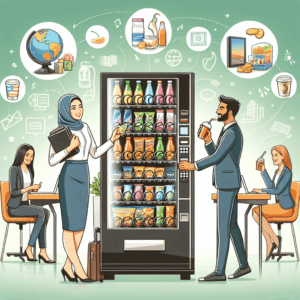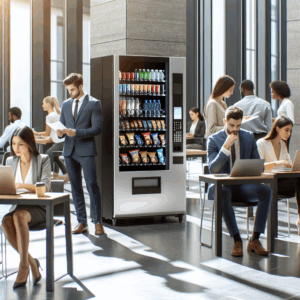Energy Inefficiency of Old Vending Machines
The Hidden Costs of Power
From my own experience, I’ve seen outdated vending machines draw energy like nobody’s business. These older machines might as well be sticking ‘free power’ signs on themselves and guzzling electricity, which spikes your energy bill unexpectedly. It’s kind of crazy to think about how much those clunky machines can cost.
The technology in these relics wasn’t built with today’s energy-saving technologies. Instead, they’re running on outdated systems that consume significantly more power than newer models. This inefficiency can end up costing operators a small fortune in utilities.
Arguably, the worst part about it is that many business owners don’t even realize how much they could save with an upgrade. It’s kind of like having an ancient car that gets 10 miles to the gallon. You won’t know how much you’re wasting until you switch to a more efficient model.
Environmental Concerns
Old vending machines have a larger carbon footprint compared to newer models because of their inefficiency. This isn’t just bad for your wallet but also unpleasant for our planet. Being kind to Mother Earth is something I take to heart, and a growing number of consumers do too.
Adaptation to more energy-efficient vending machines aligns your business with sustainable practices. It’s not just a trendy thing to do—it’s what’s needed for a future we can all live in. As we reduce our environmental impact, we not only help the planet but also appeal to a more eco-conscious customer base.
Ultimately, cutting down on energy waste isn’t just about saving money—it’s about taking responsibility for our shared planet. So if there’s ever been a time to lean towards efficient machines, it’s now.
Regulatory Compliance
An often-overlooked aspect is how outdated machines can put you out of sync with regulatory standards. Just about every business tries to avoid legal hassle, and failing to meet energy regulations can land you in hot water or at least cost you some hefty fines.
There’s a whole array of energy standards out there, and unfortunately, older models often don’t meet them. Newer machines, on the other hand, are designed with these rules in mind, meaning less stress for you on the compliance front.
Believe me, staying compliant doesn’t just keep you out of trouble—it also boosts your reputation as a responsible business. And that’s a win-win in my book.
Impact on Customer Experience
Unfortunate Malfunctions
Hey, we’ve all had running battles with a vending machine. You’re hungry, looking forward to that snack, but it jams. It’s no fun, right? Unfortunately, outdated machines tend to malfunction more frequently. That’s not the kind of experience you want to offer your customers.
If there’s one thing we’d hate to see, it’s disappointing our clients. They deserve the best service, and we should aim to provide that. I’ve learned that through my years in customer-centric roles—people remember these experiences, and not favorably.
When your vending machine doesn’t function properly, you risk losing clients to competitors with better-maintained machines. The customer frustration from machine malfunctions is something easily avoidable with a bit of investment into newer, reliable technology.
Aesthetic Appeal
Let’s face it. Those old clunky machines don’t do any favors to your establishment’s aesthetic. Imagine walking into a modern office or retail space and seeing a vending machine that’s probably as old as you are. It’s not just the functionality that matters but how things look, too.
Modern machines bring a sleek, professional look, which can align nicely with your establishment’s image. A well-placed modern vending machine can impress customers and even become an attractive feature of your place.
Looks matter more than we’d like to admit. And you don’t want to be the sore thumb in your otherwise fabulous interior. By modernizing your machines, you’re not just improving functionality but enhancing the overall vibe of your space.
Variety and Innovation
The newer machines come packed with features—I’m talking about touchscreens, cashless payment options, among others. They offer more snack variety, keep things fresh, and adjust temperature controls to suit stored items. How awesome is that?
Giving customers a variety ensures their needs are met and keeps them coming back for more. This is where new machines shine. Gone are the old days of just soda and chips; today, healthier and more diverse choices can easily be offered.
Remember, an enhanced customer experience cultivates loyalty and encourages repeat business. Investing in modern machines is not just about catching up—it’s about standing out.
Maintenance Costs and Time
Frequent Breakdowns
You know that feeling when your car’s dashboard lights up like a Christmas tree? An outdated vending machine isn’t really far off. Constant maintenance is not only time-consuming but eats into your profits. Why? Because they are more prone to breaking down.
And when machines are out of service frequently, there’s not just the repair cost to worry about. It’s the inconvenience, too. Scheduling repairs, halting sales, and dealing with customer complaints—all because your machine isn’t up to par.
Investing in newer machines reduces downtime—a big plus. Less time wasted means more time focused on what really matters: serving your customers and running your business smoothly.
Replacement Parts Availability
Tracking down replacement parts for older machines can be like finding a needle in a haystack. You know what I mean? Parts become obsolete quickly, and vendors stop stocking them, meaning every time there’s a breakdown, it’s a full-blown mission to source parts.
Even when you manage to get a hold of the required parts, more hidden costs emerge alongside extended downtime. And let’s not forget the likelihood of part incompatibility, adding frustration to the expense.
It’s a tough gig to keep outdated machines up and running. However, newer machines simplify maintenance with better-spare part availability and compatibility—streamlining the repair process efficiently.
Cost vs. Benefits of Upgrading
Upgrading means initial costs, sure. And many folks hesitate because of that. But hear me out. This is an investment with substantial long-term rewards. Weigh in the lower energy consumption, reduced maintenance cost, and increased revenue. It paints a better picture, right?
Think of it as recently making a switch to a smart TV from an ancient box that took forever to boot up. Once you experience the benefits—convenience, features, lower power bills—you realize that initial cost is totally worth it.
And with modern financing options, you won’t have to break the bank. It’s like what they say—spend a little more now to save a lot later. That’s what you’ll get with a vending machine upgrade.
Lost Revenue Opportunities
Limited Payment Options
These days, people don’t carry cash around as much anymore. And here lies one of the many problems of an outdated vending machine—the payment methods are limited or outdated. If you can’t accept the evolving range of payment methods, say goodbye to some sales opportunities.
From contactless payments, card swipes to the good ‘ol mobile wallet—newer machines offer these options, making purchases easier and faster. Customers often change their minds if they can’t pay via their preferred method. Frustrating much?
Nobody wants to walk past a vending machine because they don’t have the right payment type on them. By providing more accessible options, you don’t just gain revenue—you win convenience points with the customers.
Product Variety and Sales
As I’ve mentioned before, product variety can drive sales up. Older machines limit the kind of products you can offer, but newer machines allow a broader range. You can stock up on healthier, dietary-restricted, or niche market products, expanding your customer base further.
It gives you leverage against competition, especially if you’re offering something they’re not. You must keep an open mind about the evolving market needs and preferences because standing still puts you behind.
With modern machines, you can track sales patterns, giving insights to adapt quickly to trends and demands. Nothing spells opportunity like staying ahead of the curve and meeting customer needs just as they arise.
Advertising Spaces
Branding on older machines is a missed opportunity. Modern machines can double as advertising spaces, giving additional monetary benefits. Ever seen those digital screens on vending machines? They’re not just for looks—they’re prime advertising real estate.
Whether it’s showcasing your own brand, promoting a partner, or even selling ad space, new machines open up myriad possibilities. It’s an avenue of revenue you don’t want to bypass.
Creating partnerships for advertising on your machines can bring networks alive, leading to more revenue and brand recognition. It’s an out-of-the-box win that old machines can’t provide.
FAQ
Why are outdated vending machines considered energy inefficient?
Older vending machines consume more power because they lack modern energy-efficient technology. Their systems are less optimized, which results in higher electricity usage and costs.
How do outdated vending machines impact customer experience?
Old machines often malfunction, have limited options, and lack aesthetic appeal, leading to customer dissatisfaction. Modern machines improve customer experience with reliability and advanced features.
What are the hidden costs associated with maintaining outdated vending machines?
The costs include frequent repairs, downtime, and the difficulty in finding replacement parts—all of which can amount to a significant financial burden over time.
What opportunities are missed by not upgrading to modern vending machines?
By sticking with old machines, businesses miss out on revenue from varied payment methods, expanded product offerings, and advertising spaces that newer machines can provide.



